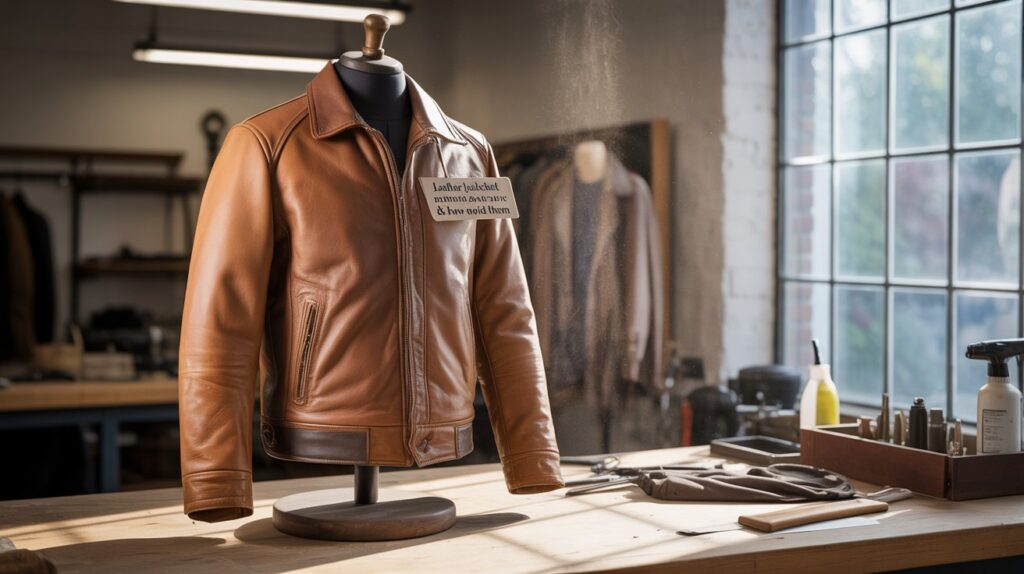Most people ruin their leather jackets without even realizing it.
It doesn’t happen overnight — it happens slowly. A few drops of rain ignored. A quick wipe with the wrong cloth. Hanging it by the collar for months.
Three years later, that once-supple jacket turns stiff, faded, and cracked.
I’ve seen this story hundreds of times — from bikers to fashion collectors to casual wearers who thought leather was “low-maintenance.” It’s not. But the good news? Every mistake that damages leather is preventable — if you understand how the material actually works.
This guide breaks down the most common leather jacket maintenance mistakes, why they happen, and how to avoid them for life-long durability.
1. Using Household Cleaners on Leather Jackets
Never use alcohol, vinegar, or baby wipes to clean leather.
They strip the natural oils that keep the hide soft and flexible. Leather isn’t like fabric — it’s skin. Just as alcohol dries out human skin, it dries leather, causing cracks, dullness, and permanent stiffness.
Why it happens:
People assume “gentle household cleaners” are safe because they work on other surfaces. But leather has a pH balance of 4.5–5.5, and most home products are far too alkaline or acidic.
Better solution:
Use a pH-balanced leather cleaner designed for jackets. Apply it with a microfiber cloth using light circular motions. Avoid spraying directly on the surface — always apply to the cloth first.
Quick tip:
If the label doesn’t say “for leather,” it’s not for leather.
2. Skipping Regular Conditioning
Leather needs conditioning every 3–6 months.
This is not optional. Leather loses its natural oils over time, especially with exposure to sunlight, wind, or dry indoor air. Without those oils, the fibers become brittle and eventually crack.
Why it happens:
Many owners believe leather is indestructible or think conditioning is “just for old jackets.” In reality, new jackets benefit the most from early care.
How to do it right:
- Clean the jacket first with a proper cleaner.
- Apply a thin layer of leather conditioner or balm (use one made for full-grain or top-grain leather).
- Let it absorb overnight.
- Buff lightly with a dry cloth.
Avoid:
- Greasy “shine creams” (they clog pores).
- Olive oil or coconut oil (they darken leather unevenly).
Pro tip:
Use conditioning cream every season if you live in a dry climate, or every 2–3 months in humid conditions.
3. Exposing Leather to Direct Sunlight or Heat
Never dry or store leather jackets near radiators, heaters, or in direct sunlight.
Heat pulls moisture out of the hide and warps its structure. The result: faded color, stiffness, and cracks around seams and sleeves.
Why it happens:
After rain, people often hang jackets near heaters or windows “to dry faster.” Unfortunately, this causes irreversible dehydration.
Safe drying method:
- Wipe off excess moisture with a dry microfiber towel.
- Lay it flat on a hanger in a well-ventilated area.
- Let it air-dry naturally at room temperature.
- Once dry, apply a leather conditioner to restore oils.
Remember:
Leather dries best slowly. Rushing the process ruins it.
4. Improper Storage Practices
Avoid storing leather jackets in plastic bags or cramped closets.
Leather needs to breathe. Without airflow, trapped humidity leads to mold growth, discoloration, and musty odors.
Common storage mistakes:
- Folding the jacket for long periods → causes permanent creases.
- Hanging it on thin wire hangers → distorts shoulder shape.
- Covering with plastic → traps moisture.
Better storage setup:
- Use a wide wooden or padded hanger.
- Cover with a cloth dust bag or tissue paper, never plastic.
- Store in a cool, dry closet with good air circulation.
- Avoid basements, attics, or areas exposed to sunlight.
Bonus tip:
Stuff sleeves and the body lightly with acid-free paper if storing for several months to maintain shape.
5. Cleaning Leather the Wrong Way
Never soak, scrub, or machine-wash a leather jacket.
Leather is porous, not waterproof. Excess water weakens the fibers and removes natural waxes that protect it.
The correct method:
- Dust off dirt using a soft vacuum brush attachment or dry cloth.
- Spot-clean gently with a damp microfiber towel and leather cleaner.
- Buff with a clean dry cloth after cleaning.
For tough stains:
Use a specialized leather stain remover or visit a professional leather cleaner. DIY fixes with toothpaste, baking soda, or alcohol usually make it worse.
6. Neglecting Zippers, Clasps, and Hardware
Metal parts need care too.
Zippers, snaps, and buckles corrode or lose shine if exposed to moisture, dust, or sweat.
What to do:
- Wipe hardware with a dry cloth after each wear.
- Occasionally apply a small drop of clear mineral oil to zippers.
- Avoid metal polishes (they stain leather).
Why it matters:
Hardware failure often leads to expensive repairs — or a jacket you can’t close.
7. Wearing It in the Rain — and Ignoring It After
Water alone doesn’t ruin leather. Neglect does.
Getting caught in light rain is fine — what matters is what you do next.
Right after exposure:
- Pat it dry gently (never rub).
- Let it air-dry naturally.
- Apply conditioner after drying.
Avoid:
- Blow-dryers or heaters.
- Storing while still damp.
Optional protection:
If you live in a rainy climate, use a leather protector spray with waterproofing agents. Apply every 3–4 months.
8. Overstuffing Pockets or Bags
Stuffing too much into pockets stretches the leather permanently.
Leather forms around the contents it holds — that’s great for shoes, terrible for jackets.
How to prevent it:
Keep pockets lightly filled. Empty them before hanging.
If you want to store accessories, use a leather bag — not your jacket pockets.
Warning:
Once stretched, leather rarely returns to its original shape.
9. Ignoring Dust and Grime Build-Up
Leather attracts dust and body oils — clean it regularly.
A fine layer of grime dulls the finish and clogs pores, preventing conditioner from absorbing properly.
Recommended routine:
- Wipe down once every 2 weeks with a dry microfiber cloth.
- Deep clean every 2–3 months with a leather cleaner.
- Always follow up with a light conditioner layer.
Pro tip:
Buff gently afterward to restore shine and smoothness.
10. Believing Leather “Gets Better” Without Care
Leather only develops a patina if it’s healthy.
That aged, glossy look collectors love doesn’t come from neglect — it comes from proper cleaning, conditioning, and storage.
What really creates patina:
- Regular maintenance.
- Natural exposure to body oils.
- Controlled wear (not abuse).
Myth to forget:
“Leather looks better the rougher it gets.”
Cracks, flakes, and dull spots aren’t patina — they’re damage.
How to Build a Simple Leather Jacket Care Routine
Daily:
- Wipe dust and moisture after wearing.
- Hang on a proper hanger in a ventilated area.
Monthly:
- Inspect seams and hardware.
- Clean spots or stains immediately.
Every 3–6 months:
- Deep clean with leather cleaner.
- Condition with leather balm or cream.
Yearly:
- Apply a leather protector.
- Store with tissue paper during off-season.
Consistency matters more than effort. A 5-minute routine every month saves you hundreds in repair or replacement costs.
Most Common Questions About Leather Jacket Maintenance
1. Can I wash my leather jacket at home?
No. Leather should never go in the washing machine. Always clean it by hand using proper leather cleaners.
2. How often should I condition my leather jacket?
Every 3–6 months. In humid climates, stretch it to 6 months; in dry ones, condition every 3 months.
3. Can I iron my leather jacket?
No. Heat damages the surface. Use a steamer nearby (not directly on it) to relax wrinkles, or let it hang naturally.
4. How can I remove a smell from leather?
Air it out. Place it in a ventilated space with silica packets or activated charcoal bags. Avoid spraying perfumes or deodorants directly.
5. Is sunlight really harmful?
Yes. Prolonged exposure causes fading and dryness. Short exposure for ventilation is fine — long-term isn’t.
6. Can cracked leather be repaired?
Minor cracks can be fixed. Use a leather repair kit or consult a professional. Deep cracks require patching or refinishing.
Why Trust This Guide
This isn’t theory — it’s the result of years of real-world leather handling, restoration work, and customer feedback from thousands of jacket owners.
Every tip here is based on tested materials, manufacturer recommendations, and industry-backed care principles.
Leather lasts decades — but only when you treat it like what it is: a living, breathing material that deserves respect.
Avoid these mistakes once, and your jacket will outlive fashion trends, seasons, and even you.
At The Falcon Jackets, we believe a leather jacket isn’t just clothing — it’s an investment in timeless style.
With the right care and a little attention, your Falcon jacket will age beautifully, tell your story, and last for decades.

